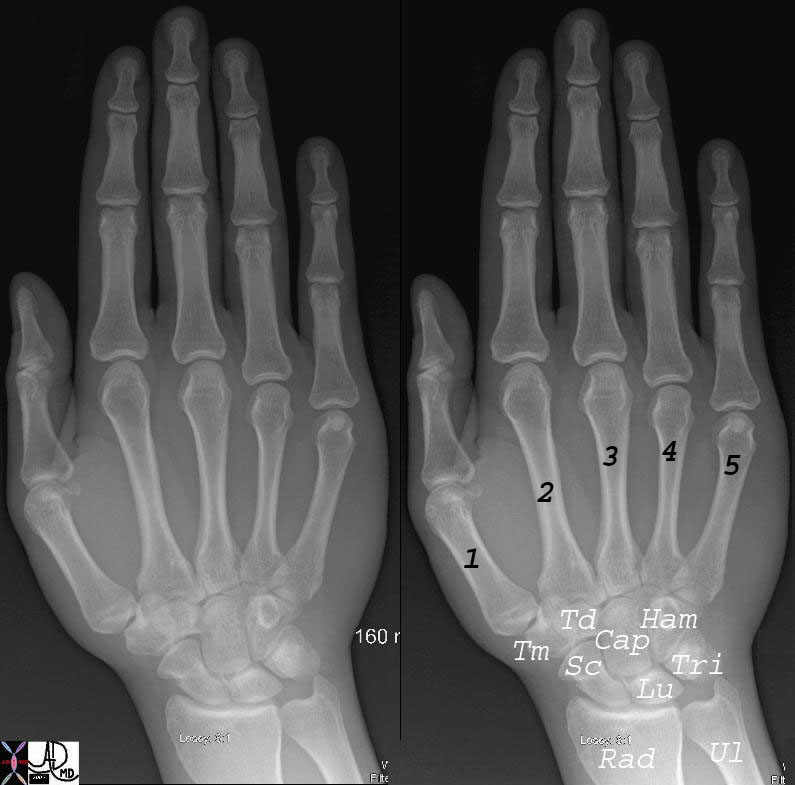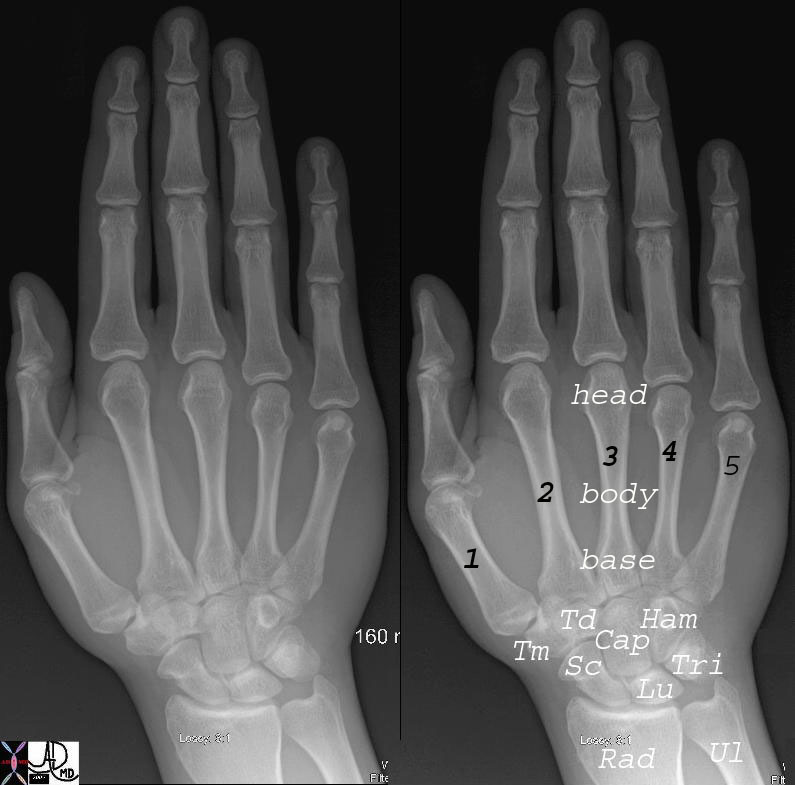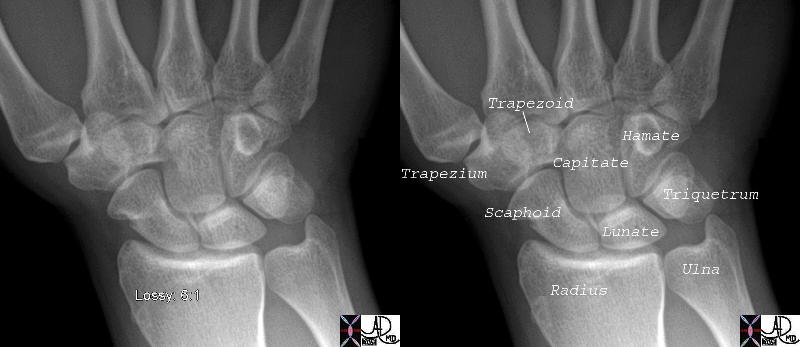Assistant
Definition

Naming the Digits |
| 45737c02b hand wrist phalanx phalanges radius ulna wrist carpals carpal bones scaphoid lunate triquetrum pisiform hamate hook of hamate capitate tapezoid trapezium metacarpals metacarpal bone sesamoid head body shaft base mip dip pip thumb index middle ring pinky proximal interphalangeal distal interphalangeal middle interphalangeal normal anatomy plain film Courtesy Ashley Davidoff MD 45737 45738 45739 45741 |

Metacarpals |
| 45737c03b hand wrist phalanx phalanges radius ulna wrist carpals carpal bones scaphoid lunate triquetrum pisiform hamate hook of hamate capitate tapezoid trapezium metacarpals metacarpal bone sesamoid head body shaft base mip dip pip thumb index middle ring pinky proximal interphalangeal distal interphalangeal middle interphalangeal normal anatomy plain film Courtesy Ashley Davidoff MD 45737 45738 45739 45741 |

Normal Wrist |
| 45738c01 bone hand wrist radius ulna wrist carpals carpal bones scaphoid lunate triquetrum pisiform hamate hook of hamate capitate tapezoid trapezium metacarpals metacarpal bone normal anatomy plain film Courtesy Ashley Davidoff MD 45737 45738 45739 45741 |
By: Gregory R. Waryasz, MD
The metacarpals of the hand are characterized by being 5 separate bones.
They are part of the bones of the hand. They consist of bone and cartilage.
The unique structural feature is that each metacarpal bone has a similar structure including a head, shaft/body, and base.
The 1st metacarpal articulates with the trapezium and its proximal phalanx. It is the thickest and shortest of the metacarpals. The base is saddle-shaped.
The 2nd metacarpal articulates with trapezium, trapezoid, capitates, 3rd metacarpal, and its proximal phalanx. It is the longest. It has the largest base.
The 3rd metacarpal articulates with the capitate, 2nd metacarpal, and 4th metacarpal, and its proximal phalanx. It has a styloid process.
The 4th metacarpal articulates with the capitates, hamate, 3rd metacarpal, 5th metacarpal, and its proximal phalanx. It has a small quadrilateral base and narrow shaft.
The 5th metacarpal articulates with the hamate, 4th metacarpal, and its proximal phalanx. It has a tubercle at the base for the extensor carpi ulnaris.
The metacarpal body is the primary ossification center and ossifies at 8 weeks of fetal gestation. The ossification center at the neck appears before age 3. The 1st metacarpal has its secondary ossification center at the base. The metacarpals as well as all other bones, muscles, and ligaments of the body are derived of mesodermal origin in embryo.
The function of the metacarpals is to connect the carpal bones to the phalanges.
Common diseases include arthritis, fracture, pseudohypoparathyroidism, pseudopseudohypoparathyroidism, Turner syndrome, and osteomyelitis.
Arthritis can occur as a result of aging and use (osteoarthritis), rheumatoid arthritis, or as a result of post-traumatic changes.
Fractures can occur at the metacarpal head, neck, shaft, or base.
A reverse Bennett fracture is a fracture-dislocation of the base of the 5th metacarpal and hamate.
A Bennett fracture is a fracture through the major part of the 5th metacarpal from the collar lip disrupting the carpometacarpal joint. The fragment is pulled proximally by the abductor pollicis longus.
A Rolando fracture is a comminuted Bennett fracture. This requires more force to get this fracture pattern type.
A Boxer’s fracture is a fracture of the metacarpal head.
Pseudohypoparathyroidism and pseudopseudohypoparathyroidism can have shortened 4th and 5th metacarpals.
Turner syndrome may be associated with a shortened 4th metacarpal bone.
Osteomyelitis is an infection of the bone typically due to bacteria.
Commonly used diagnostic procedures include clinical history, physical exam, plain radiographs, CT scan, bone scan, and MRI.
It is usually treated with either non-operative methods or operative methods for fractures can be treated with surgery, physical therapy, or NSAIDs. Osteomyelitis is treated with surgery and antibiotics. Congenital disorders like Turner Syndrome do not require treatment for the metacarpal.
References
Elstrom J, Virkus W, Pankovich (eds), Handbook of Fractures (3rd edition), McGraw Hill, New York, NY, 2006.
Koval K, Zuckerman J (eds), Handbook of Fractures (3rd edition), Lippincott Williams & Wilkins, Philadelphia, PA, 2006.
Lieberman J (ed), AAOS Comprehensive Orthopaedic Review, American Academy of Orthopaedic Surgeons, 2008.
Moore K, Dalley A (eds), Clinically Oriented Anatomy (5th edition), Lippincott Williams & Wilkins, Philadelphia, PA, 2006.
Wheeless’ Textbook of Orthopaedics: Hand and Metacarpal Fractures (http://www.wheelessonline.com/ortho/hand_and_metacarpal_fractures)
